Key takeaways:
- Hospital ministry emphasizes the importance of spiritual care, active listening, and compassion to support patients and their families during challenging times.
- Visualization for healing involves mental imagery that can reduce stress, boost motivation, and foster a connection between mind and body, significantly impacting emotional and physical well-being.
- Effective visualization techniques include personalization, the use of affirmations, and creating vision boards to enhance motivation and clarity in healing goals.
- In hospital visits, encouraging patients to visualize their healing journey can transform their mindset, alleviate anxiety, and connect them with positive memories for comfort and empowerment.

Understanding Hospital Ministry
Hospital ministry is a unique blend of spiritual care and healthcare. It’s not just about visiting patients; it’s about forming connections during some of life’s most challenging moments. I remember a time when I sat with a patient who felt abandoned. As we talked, I could see how sharing his fears lightened his burden. In that moment, I felt the true essence of hospital ministry—being present can often be more powerful than any words.
In my experience, hospital ministry involves active listening and compassion. There are days when the tension in the room is palpable, and I often wonder how I can best support someone in distress. Reflecting on my interactions, I realize that empathy can pave the way for healing. When I offer comfort and a listening ear, I can almost feel the shift in energy; it’s as if hope is reborn in the silence that follows.
Furthermore, the impact of hospital ministry extends beyond individual patients. I’ve seen how family members can be uplifted just from a simple gesture or a warm conversation. Have you ever noticed how a small act of kindness can lighten the heaviness of a hospital environment? In my journey, I’ve discovered that each interaction can foster resilience and courage amidst uncertainty, creating a ripple effect that can transform the entire atmosphere in a hospital setting.
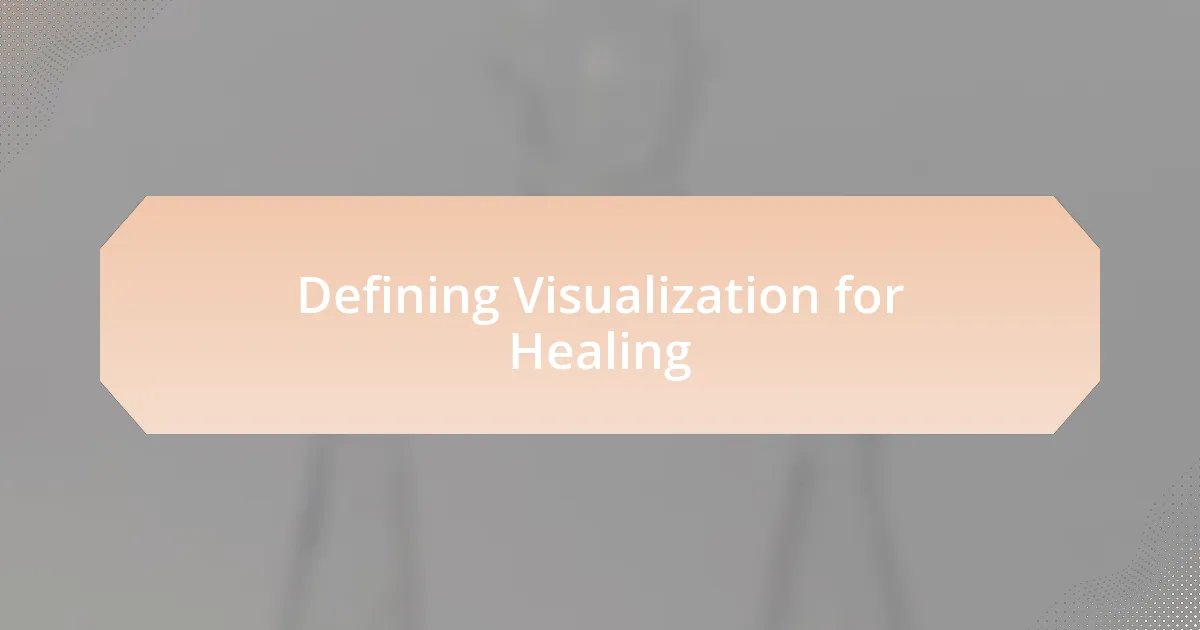
Defining Visualization for Healing
Visualization for healing is a powerful mental technique that encourages individuals to picture a state of well-being, health, or even emotional peace. When I engage in visualization, I often find myself conjuring up serene images that promote a sense of comfort and healing in my mind. Just the act of imagining a soft, warm light enveloping me during stressful moments can create a profound sense of calm.
As I reflect on my experiences, I realize how vividly visualizing positive outcomes has helped others around me. I remember guiding a friend through a challenging recovery. I encouraged her to visualize each step of her healing journey, which not only eased her anxiety but also empowered her to believe in her strength. Have you ever experienced the impact of mental imagery in your own healing process? It’s fascinating how the mind can influence the body and spirit.
Ultimately, visualization is more than mere daydreaming; it’s an active practice that harnesses the power of thought for healing purposes. Each time I focus on positive imagery, I can almost feel my body responding, as if creating an internal dialogue that resonates with hope and vitality. It reminds me that nurturing our inner world can significantly impact our physical reality—one image at a time.
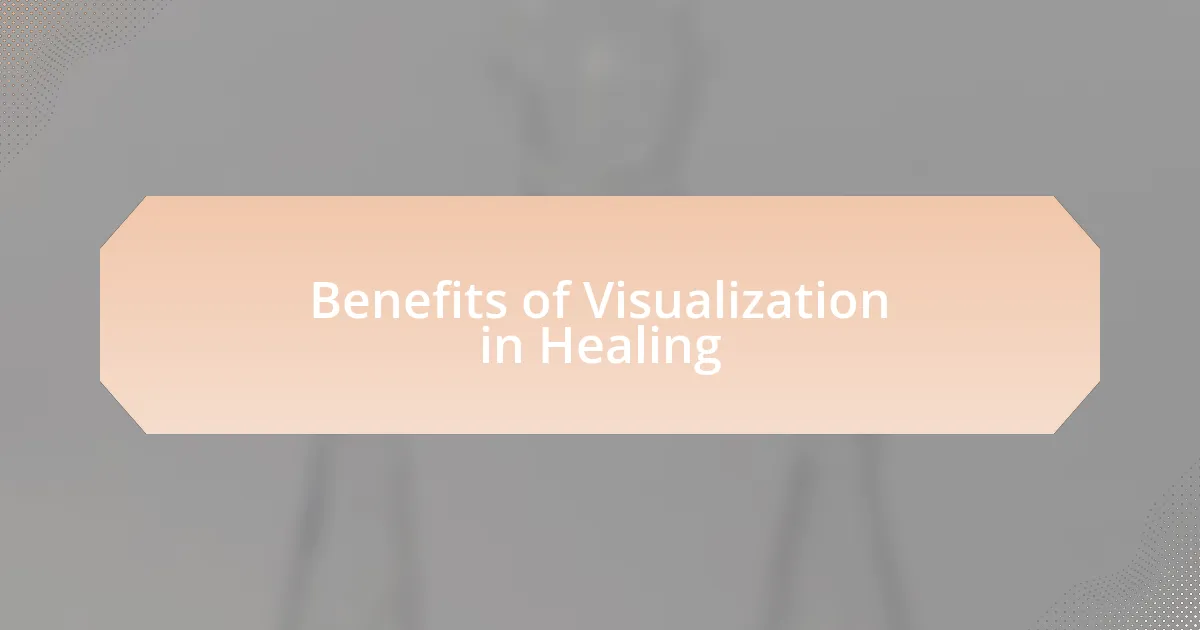
Benefits of Visualization in Healing
Engaging in visualization has numerous benefits that can enhance the healing process. One striking advantage is the reduction of stress and anxiety. When I envision a peaceful scene, like a tranquil beach at sunset, I can almost absorb the calmness as if I were there. This mental retreat not only alleviates my worries but also promotes physical relaxation. Have you ever noticed how imagery can transport you to a better emotional space? It’s quite remarkable how quickly our mind can shift our mental and physical state.
Another benefit I’ve observed in myself and others is the boost in motivation and resilience it provides. Visualizing specific goals, whether it’s participating in an activity or recovering from an illness, allows me to see the achievable paths clearly. For instance, during my own recovery from a minor surgery, picturing myself engaging in activities I love—like hiking—kept my spirits high. Visualization became a source of fuel that pushed me to engage in my rehabilitation exercises with renewed determination. Isn’t it empowering to realize that our imagination can serve as a catalyst for action?
Moreover, visualization fosters a deeper connection between mind and body. I’ve often found that when I visualize a health-related goal, my body seems to respond almost instinctively. Whether it’s picturing healing energy flowing through me or visualizing myself energized and active, these mental exercises create a sense of ownership over my healing. It’s fascinating how this connection can inspire hope, paving the way for transformative changes. Have you experienced a shift in your own healing journey through visualization? These moments of realization can be truly profound and affirming.

How Visualization Helps Patients
Visualization can significantly aid patients by enhancing their emotional well-being. I remember a time when a friend faced a challenging diagnosis. We sat together, and I encouraged her to visualize her recovery journey. Her eyes brightened as she began to picture herself enjoying life fully again. This simple act of envisioning a healthier future not only lifted her spirits but also helped her cope with the emotional weight of her situation. Have you ever noticed how a positive mental image can clear the fog of uncertainty?
Furthermore, visualization can physically impact patients by influencing their perception of pain. I recall an instance when I was recovering from a sports injury; I would close my eyes and visualize my body healing, actively reducing my pain levels. As soon as I imagined the pain dissipating, it felt more manageable and less overwhelming. Isn’t it interesting how our mind can produce tangible relief through focused thought?
Lastly, visualization encourages a proactive approach to health. I have seen patients become more engaged in their recovery plans after visualizing milestones like returning to their hobbies. This active participation seems to forge a pathway to recovery that feels both achievable and motivating. Have you considered how visualizing your goals might inspire you to take healthier steps in your own life? It’s a powerful reminder that our mental images can shape our reality.
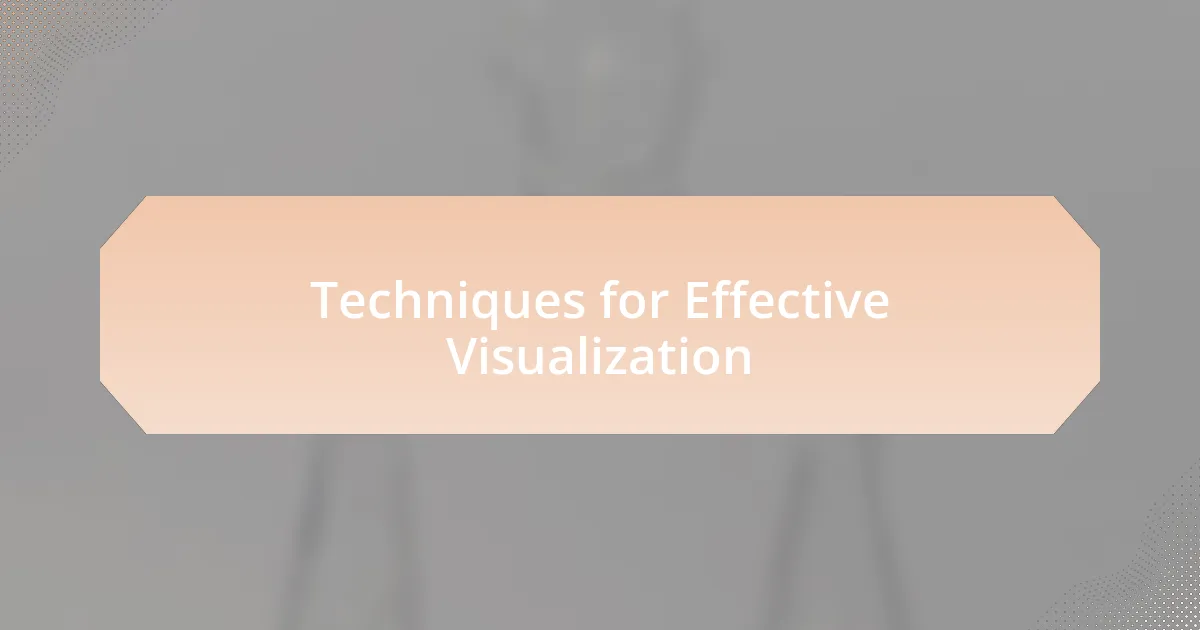
Techniques for Effective Visualization
Visualization techniques are most effective when they are tailored to the individual. I once worked with a patient who found deep relaxation through guided imagery, specifically focusing on her favorite beach. I guided her through the process, prompting her to imagine the sound of the waves and the warmth of the sun on her skin. Seeing her tension ease in real-time reinforced my belief that personalizing visualization can enhance its impact significantly. Have you ever considered how a setting that brings you peace could be your starting point?
Another technique involves using affirmations in tandem with visualization. I’ve experienced the power of affirming statements while picturing my desired outcomes. For example, while envisioning a successful presentation, I repeated phrases like “I am confident” and “I am prepared.” This combination not only solidified my mental imagery but also instilled a sense of empowerment that translated into reality. Have you tried pairing positive affirmations with your mental imagery for a more profound effect?
Lastly, creating a vision board can be a tangible way to reinforce your visualization practice. I remember putting together a collage filled with images and words that symbolized my healing journey and future aspirations. Each time I glanced at it, I felt an invigorating surge of motivation and hope. This visual representation became a powerful reminder of possibilities. How might a vision board inspire you to keep focused on your healing goals?
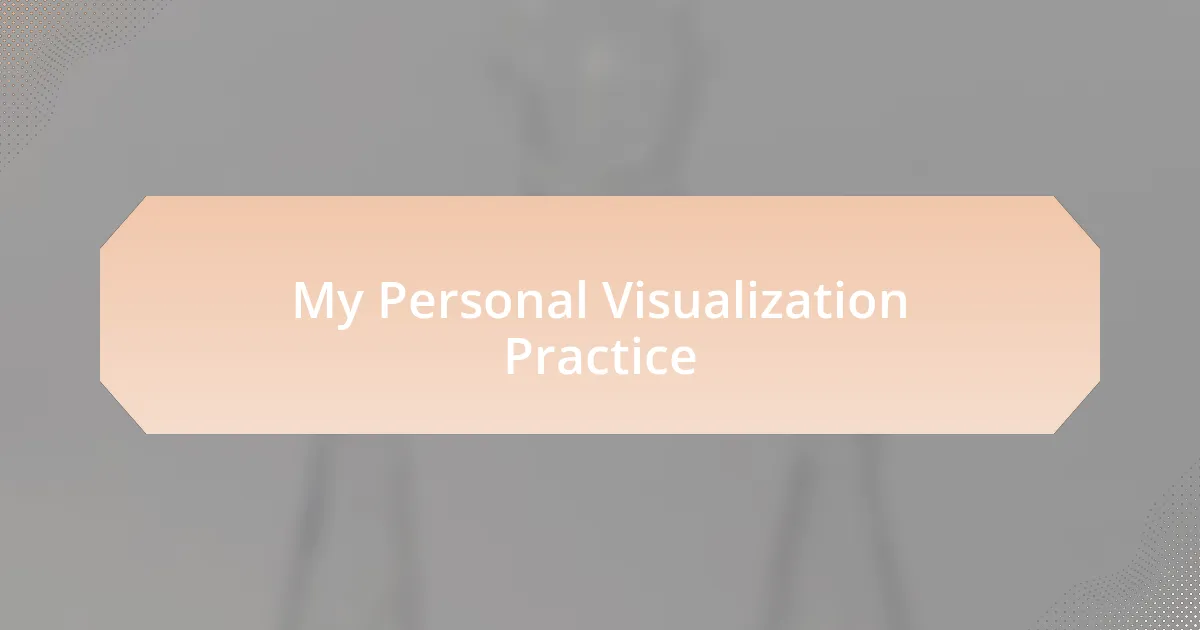
My Personal Visualization Practice
My visualization practice is deeply personal and often evolves as I do. In one memorable instance, I found myself picturing a serene lake during a particularly stressful week. As I immersed myself in this mental image, I could almost smell the crisp air and feel the cool water lapping at my feet. Embracing this imagery brought an unexpected calmness that lingered long after the visualization ended. Have you ever felt a specific place in your mind dissipate stress like that?
I also incorporate mindful breathing into my visualization routine. Recently, I’ve begun taking a few moments to focus on my breath before diving into my visualizations. Inhale deeply, hold for a moment, and then exhale slowly while envisioning any negativity leaving my body. This simple practice has profoundly enhanced my clarity and connection to the images I create. Have you noticed how a few deep breaths can alter your mindset?
Another vital element of my practice involves visualizing the healing process itself. During one challenging time, I imagined vibrant energy flowing through my body, healing and revitalizing every cell. Visualizing this energy not only transformed my perception of discomfort but also ignited a sense of empowerment within me. Reflecting on this experience, I ask myself: how can harnessing your inner strength through visualization change your approach to healing?
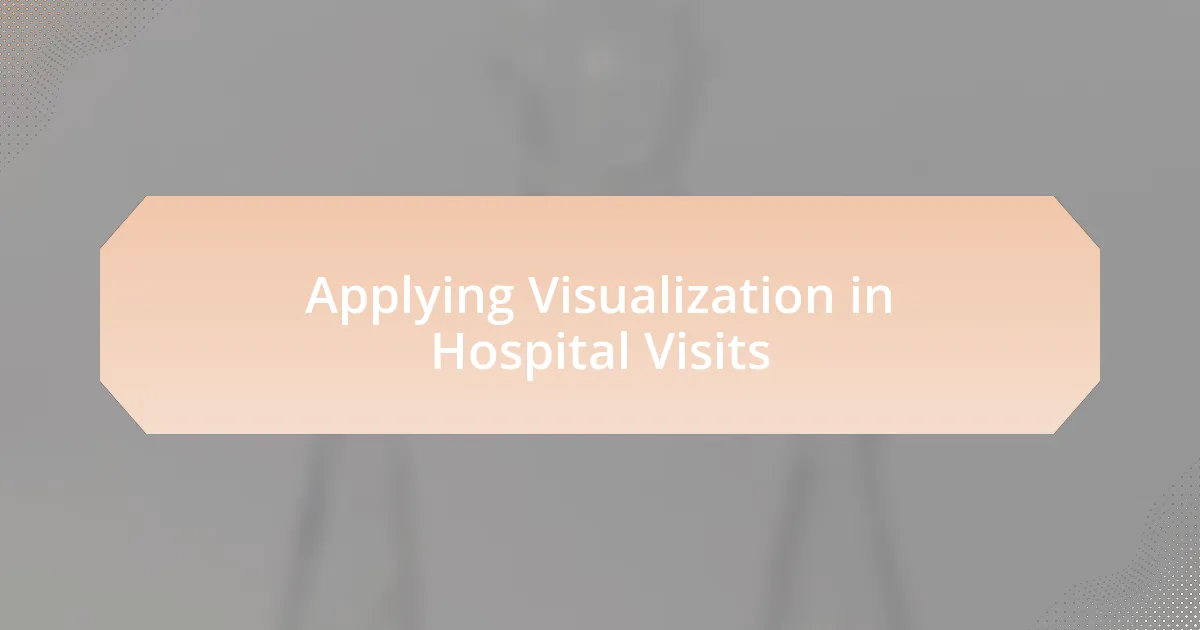
Applying Visualization in Hospital Visits
When I visit patients in the hospital, I often encourage them to visualize their healing journey. For instance, during one visit, I guided a young mother who felt anxious about her treatment to imagine herself surrounded by vibrant, healing light. As she embraced this visualization, I noticed a palpable shift in her demeanor; her tension eased, and a hopeful smile replaced her worry. Have you ever seen how imagining a positive outcome can instantly change someone’s perspective?
I also find that weaving stories into visualizations can deepen the experience. Once, I shared a narrative about a brave warrior overcoming obstacles, paralleling her own struggles with health. This narrative not only made the concept of healing more relatable but also empowered her to feel like she was on her journey to triumph. Don’t you think sharing personal stories can make a visualization more impactful?
Another approach I use is to connect with patients through their own memories, enabling them to visualize a place that brings them joy or peace. I remember one elderly gentleman who spoke of a beloved garden where he spent his childhood. As we painted a mental picture of that garden together, the warmth and love he associated with it created a sense of comfort, lifting his spirits dramatically. How powerful can our cherished memories be in the healing process?